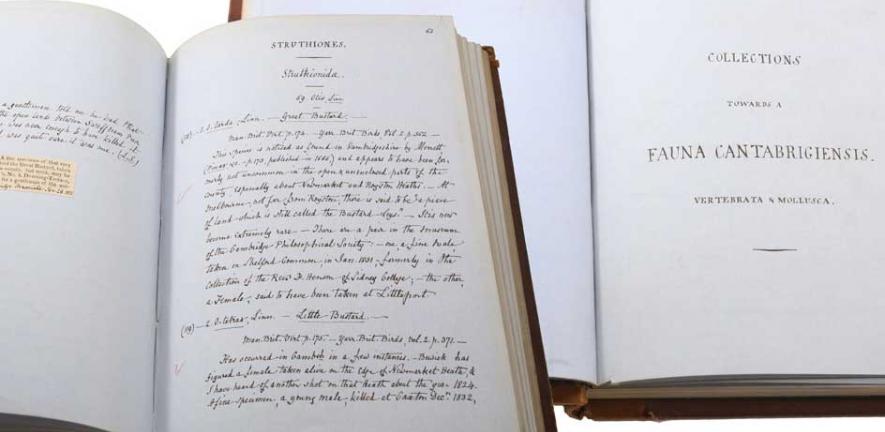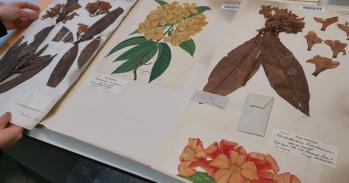
A notebook recording the fauna of Cambridgeshire observed and collected by the Reverend Leonard Jenyns between 1820 and 1849 has been published in full for the first time. A significant naturalist in his own right, Jenyns turned down the offer of a place on HMS Beagle, recommending instead a younger colleague, Charles Darwin.
A notebook recording the fauna of Cambridgeshire observed and collected by the Reverend Leonard Jenyns between 1820 and 1849 has been published in full for the first time. A significant naturalist in his own right, Jenyns turned down the offer of a place on HMS Beagle, recommending instead a younger colleague, Charles Darwin.
Jenyns used his vicarage at Swaffham Bulbeck on the edge of the Cambridgeshire fens as a base for studying the flora and fauna of the region, as well as its meteorology.
The University Museum of Zoology, Cambridge, is a magical and light-filled space where it is possible to see many of the specimens collected by the most famous naturalists of the 19th century. They range from specimens collected by Darwin on the Beagle voyage to a range of fossils and other specimens collected more recently. Behind the scenes of the museum, its archives contain thousands of original documents, which chart the development of fields as diverse as comparative anatomy and palaeontology from their beginnings and throw a light on the extraordinary personalities involved in forging these disciplines.
Among these treasures is a set of notebooks filled with the meticulous handwritten records made by the Reverend Leonard Jenyns, Vicar of Swaffham Bulbeck, between 1827-1849. In them he describes many of the species that occurred in Cambridgeshire during the mid-19th century. One of these notebooks, which he gave to the museum in 1869, includes an entry about an eel-like fish called a Burbot. Writing in beautiful copperplate, Jenyns noted that the Burbot was: “Common in the Cam, and in the navigable cuts communicating with that river. In Reche Lode they are frequently taken, & sometimes attain to a considerable size, reaching the length of nearly two feet, and the weight of between three or four pounds.”
Once so widespread, the Burbot has been considered extinct in Britain since the late 1960s. It is just one of many species which flourished in East Anglia during the mid-19th century and have now declined in number or disappeared completely. Jenyns mentioned a number of species found only as fossils in the fens, such as Beaver and Wild Boar, but he also listed other species that have disappeared from Cambridgeshire more recently including the Natterjack Toad (once abundant at Gamlingay), the Swallowtail butterfly (common throughout the fens), as well as dozens of less well known species. Amongst the birds, Jenyns described the Nightingale as “very abundant” and the Wryneck as “common in the spring”, whereas Red Squirrels were “common in some of the more wooded parts of the County”, especially in the park at the Gogmagog Hills, where they were “very plentiful”. Such changes may seem dramatic to us but even Jenyns, writing in the mid-19th century, was bemoaning the loss of local wildlife that had resulted from fenland drainage, enclosure and changes in farming practice.
From the 1820s Leonard Jenyns (1800-1893) and his fellow naturalist and brother-in-law John Henslow (1796-1861) set out to produce an extensive natural history of Cambridgeshire, making detailed records of its fauna and flora, but both men were forced to leave the county before this was completed. However, in 1869 Jenyns sent to Cambridge six notebooks on natural history to be deposited in the University Museum of Zoology where the collections of many of the animals to which they relate are preserved.
Now the Jenyns’ notebook covering the vertebrates and molluscs of Cambridgeshire has been published for the first time. It takes its title, Fauna Cantabrigiensis, from the inscription on the original volume. Transcripts of Jenyns’ original notes (recorded complete with idiosyncrasies of style and spelling) detailing his acquisitions and observations are accompanied by notes contributed by the book’s editors – Dr Richard Preece (University of Cambridge) and Dr Tim Sparks (Coventry University) – who wherever possible compare the prevalence of the species recorded in the mid-1800s with data on the distribution of the same species today.
The transcripts are preceded by a biography of Jenyns that makes fascinating reading. He was part of a group of naturalists – many educated at Cambridge and subsidising their forays into natural history with positions as country clergymen – who helped to establish the modern fields of zoology, botany and geology. In his later years Jenyns recalled the first few decades of the 19th century as a golden age for the study of natural history at Cambridge – a time that saw the foundation of internationally important collections and learned societies. Henslow hosted soirees open to anyone with an interest in natural history and he led field excursions, which were well attended. Jenyns noted that the appetite from entomologists for rare species of insect was so great that “several persons among the lower classes derived a part of their livelihood during the summer months from collecting insects for sale, especially in the fens”.
The newly published volume covers more than 400 entries made by Jenyns in a notebook that covers the period 1820-1849. It also includes dozens of contemporary illustrations and photographs of species collected at the time, many of which formed the basis of the Museum of the Cambridge Philosophical Society (a collection which later became the nucleus of the University Museum of Zoology). The remarkable accuracy of Jenyns’ natural history observations, together with his meteorological records (published in 1858) provide valuable historical baseline data from which it is possible to gauge faunal changes over time – a vital component in understanding the impact of factors such as land use and climate change.
A striking aspect of Jenyns’s career was his relationship with other well-known figures. When in 1831 Captain Robert Fitzroy was looking for a naturalist to accompany him on a five-year voyage of discovery on HMS Beagle, he got in touch with a friend in Cambridge who suggested Henslow and Jenyns. Both declined his offer, Henslow on the grounds of family responsibilities and Jenyns out of concern for his parish duties. However, they put forward the name of a younger naturalist who they agreed “in all respects would be a fit man to go”.
The man they recommended was Charles Darwin, whose Beagle voyage was to lay the foundations for our understanding of evolution. It has been said that Jenyns “always regretted his unimaginative decision” although it appears that he was not jealous and considered “that no better man could have been chosen for the purpose” than Darwin. There had, however, been tensions between the two early in their relationship with Darwin writing much later that he had at first disliked Jenyns for “his somewhat grim and sarcastic expression”, an opinion he completely revised when he found him to be “very kind-hearted, pleasant and with a good stock of humour”.
While Darwin journeyed down South America to the Galapagos Islands, collecting many species unknown to those back home, Jenyns used his vicarage at Swaffham Bulbeck on the edge of the Cambridgeshire fens as a base for studying the much more familiar flora and fauna of the region, as well as its meteorology. His studies coincided with a period of rapid change in East Anglia where the demand for rich arable land to grow foodstuffs for the burgeoning population resulted in increasingly efficient drainage of wetlands. The drainage of the last mere (inland lake) at Whittlesey, an expanse of shallow water almost as large as Lake Windermere, represented a drastic loss of habitat that was quickly noticed by contemporary naturalists who bemoaned declining numbers of species such as harriers, Red Kites, Bearded Tits and Bitterns.
When Darwin returned from his voyage in 1836 he asked his friend Jenyns to undertake the task of describing the fish he collected. This was a challenge as Jenyns had previously worked only on British fish but, making use of books from Cambridge University Library, he set about identifying hundreds of known specimens and writing descriptions of new ones. Weeks of intensive work on Darwin’s fish prompted Jenyns to remark that the mere mention of Darwin’s name evoked a fishy smell for him, a fact that greatly amused Darwin. Jenyns’s notebook inscribed on the title page “Notes on the Fishes Collected by Charles Darwin Esq in the Voyage of HMS Beagle” is one of many treasures held by the University Museum of Zoology, Cambridge.
Jenyns travelled widely within Britain but never ventured overseas. He left the damp fens, and consequently abandoned his project of recording its fauna, for the sake of his wife’s health. He eventually settled in Bath, where he co-founded the Bath Natural History and Antiquarian Club, claiming to have transformed the city from a “a place of darkness and stagnation in respect of intellectual and scientific pursuits” to a centre of enlightenment. He climbed Snowdon in 1871, the same year that he was obliged to adopt the name Leonard Blomefield in order to inherit an estate in Norfolk. He was blessed with such excellent eyesight that as an octogenarian he was able to write the Lord’s Prayer on a piece of paper the size of a sixpence.
Fauna Cantabrigiensis: The vertebrate and molluscan fauna of Cambridgeshire by the Rev. Leonard Jenyns (1800-1983): transcript and commentaries is edited by Richard C Preece and Tim H Sparks, and published by The Ray Society. https://www.raysociety.org.uk/ Dr Preece is Reader in Quaternary Malacology and Senior Assistant Curator in the University Museum of Zoology, Cambridge. He is a specialist in molluscs, both modern species and those of the Quaternary Ice Age. Dr Sparks is a Senior Lecturer at Coventry University. He has wide interests in conservation, environmental change and interpretation of data.
This work is licensed under a Creative Commons Licence. If you use this content on your site please link back to this page.





